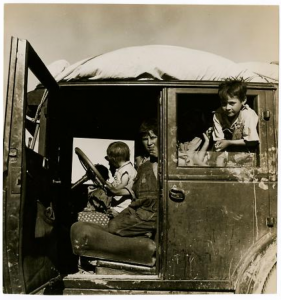Ten Children, March 1937, by Dorothea Lange,
for the RA (courtesy of OMCA)
Text by Bruce Berman
Migrants looking for work goes back the very beginning of America, from the English/Europeans at Jamestown and beyond. One could arguably say that “Native Americans” descended from migrants from China, coming across the Bering land bridge.
In Lange’s era, as the economic Depression of the 1930s deepened and the ecological disasters of drought and erosion progressed there was a massive infra-country migration, primarily from the Great Plains and Texas/Oklahoma, mostly heading west to California.
This migration was heavily documented by the FSA and by others.
Dorothea Lange was deeply sympathetic to the plight of these migrants, heightened by her acute awareness of their conditions as she accompanied her husband, Paul Taylor, who was a “progressive economist” at the University of California, Berkeley where he was a professor of economics until his retirement in 1962.
Lange and Taylor were a powerful one-two punch. She had an extraordinary skill of making visual what Taylor made factual. Her images combined with his research and resulting writing had as much to do with bringing awareness to the plight of the dispossessed of the 1930s as did any other organization, bureaucracy or individual.
Talor used his research and skillful interviewing as a weapon to support FDR’s socialized programs and Lange used her camera -and eye- as a sword in the battle for empathy, aid and awareness of the conditions of dispossessed people.
The image presented here is in the permanent collection of the Oakland Museum of California (OMCA). On the back of the print, she penciled the following: “Ten children are in this car of drought refugees from Oklahoma. No work, no money, car stalled. Riverside Co. Calif. March ’37” and “Kindly use the following credit: Resettlement Administration Photograph by…” Here she ink-stamped her name, “Lange.”

